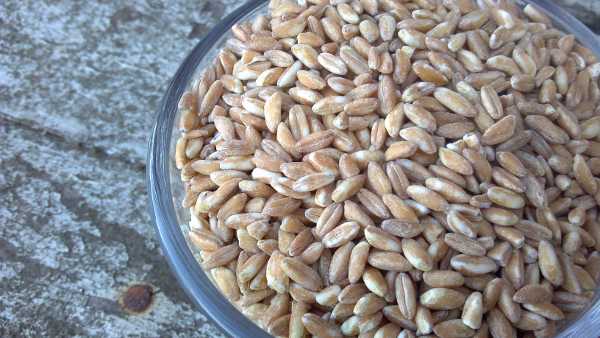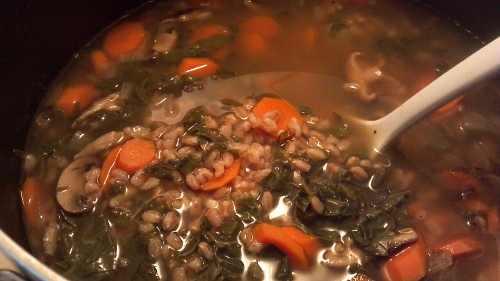
Writing about farro (pronounced FAR-oh) reminds me of reciting the adage that has dictated a bride’s attire for centuries: “Something old, something new, something borrowed, something blue.”
Well, maybe without the borrowed and blue part.
Farro is both old and new in that it’s an ancient grain that has made a recent resurgence in the foodie community, even becoming the “grain du jour” in some upscale restaurants over the last few years.
I tasted it for the first time some months ago when my sister-in-law brought a salad home from a catered business lunch. Colorful roasted vegetables accented the farro in the dish, and I thought the grain resembled a plump version of barley. It also had the chewy texture of that grain.
As a barley fan since early childhood, I pronounced it delicious and looked forward to learning more about it and adding it to my culinary repertoire.
Farro, also known as emmer wheat, is a cereal grain that dates back some 20,000 years. The first cultivated grain, it’s the ancestor of modern wheat.
It fed the Mediterranean and Near Eastern populations for thousands of years, and was the primary grain grown by early Egyptians.
The Roman legions discovered farro during their occupation of Egypt, and it eventually became a staple grain for them.
Writer Nico Valerio opines that it was the high protein and vitamin content of “grano farro” (as it’s known in Italian) that was the foundation of the Romans’ military prowess. In other words, it was farro, not “ferro” (that is, metal weapons) that created the Empire.
The Romans boiled farro or made bread from its flour, and the grain’s slow release of energy was reinforced by greens, fruit and cheese. According to Valerio, these were ideal foods for Roman warrior/farmers who “founded the republic and went on to conquer the world.”
In addition, farro was a staple of the Roman poor, who ground it into a paste and cooked it to make a polenta-like dish known as “puls.”
Despite its importance as a food, farro eventually fell out of favor. It was difficult to work and produced low yields.
In the centuries following the fall of the Roman Empire, higher-yielding and easier-to-grow grains were developed and cultivation of farro dwindled.
By just over a hundred years ago, at the turn of the last century, there were only a few hundred acres of farro fields scattered over the Italian regions of Lazio, Umbria, the Marches and Tuscany.
Thankfully, this wonderful grain has been unearthed in recent years.

Farmers in the Haute-Savoie region of neighboring France began supplying farro to elegant restaurants, and its successful use in hearty soups and other dishes sparked renewed interest in the grain.
Farro’s popularity spread among gastronomes, and a love of farro has been rekindled in Italy, especially among trendy and health-conscious cooks.
It can be found in soups, salads, and even desserts in that country. A risotto-like dish may be made with it as well, cleverly dubbed by some as farrotto.
In Florence, farro salad is a popular lunchtime dish, often simply adorned with fresh basil, chopped tomatoes, and mozzarella. In the winter, “zuppa di farro,” a hearty vegetable soup, is a staple there.
What had morphed into an obscure local crop has now become a phenomenon in the culinary world, with Tuscany’s Garfagnana area granted “Protected Geographical Indication” status for its Farro della Garfagnana.
Farro’s rich, nutty flavor and chewy texture makes a delightful base for salads of all types.
Roasted vegetables from squashes to beets, fresh tender greens, cheeses like ricotta salata or Parmigiano Reggiano, toasted nuts, or lightly cooked vegetables like asparagus or peas are nice complements to farro.
The only limit is your imagination.
As to soup, use farro as you would barley, allowing it to cook in the broth to absorb wonderful flavor.
Farro can also be used as a side dish, similar to rice. Its flour makes beautiful pasta and breads.
Cooked dried beans of all types are wonderful companions for farro in both salads and soups, forming a complete protein when eaten together.
Since farro is imported from a small swath of Italian regions, it may be difficult to find in the supermarket, but give it a try. Thankfully, it’s available in well-stocked Italian delis, specialty and natural food stores, and online.
Because it’s a low-yield crop, it’s a pricey little grain. I paid over $5 (on sale) for just over a pound of it, but I’m happy I did.
Semi-pearled farro, or “farro perlato,” cooks much more quickly than farro with its tough hull intact. The version I purchased cooked in about 20 minutes. With the hull, it can take up to an hour.
Farro is often confused with spelt (the same word in Latin refers to both), but they are different grains. Farro maintains its dense, chewy structure when cooked, whereas spelt becomes mushy.
I just made an immune-boosting soup with healthy farro as the grain. The nutty scent emitted while cooking was rich and enticing.
I added farro to the soup for its flavor and texture, but it turns out the grain has immune-boosting qualities, thanks to a carbohydrate it contains called cyanogenic glucosides. This carbohydrate also lowers cholesterol and helps maintain blood sugar levels.
Farro has twice the fiber and protein than modern wheat. While it does contain gluten, the gluten molecules are weaker than in modern wheat, making it more easily digested.
A quick search online for farro recipes will yield wonderful results. For today’s recipe, I chose a warm farro salad with roasted vegetables from food blog www.thekitchn.com .
For vegetarians, this warm, comforting salad can be enjoyed as a main dish; meat eaters may chose to use it as a hearty side dish or add cooked bacon or strips of prosciutto to make it complete.
Enjoy! And happy Sunday.
Warm farro salad with roasted vegetables and fontina
Serves two to three as a main dish
2 medium carrots, peeled and cut into small chunks
1 cup grape tomatoes
6-8 cremini mushrooms, cut into small chunks
4 cloves garlic, peeled and quartered
1 small red onion, sliced
4 tablespoons olive oil, divided
1 teaspoon kosher salt
1/2 teaspoon pepper
1/2 of a small head of radicchio, cored and sliced into chunks
1 cup farro
2-3 ounces fontina cheese, cut into small cubes
small handful of chopped parsley
1 tablespoon balsamic vinegar
Preheat the oven to 400 degrees.
Combine the carrots, tomatoes, mushrooms, garlic, and onion in a large bowl. Add 2 tablespoons of olive oil, salt and pepper, and toss to coat. Spread the vegetables on a baking sheet lined with foil or parchment paper, and roast for 15 minutes, stirring once.
Add the radicchio to the pan, toss to get it covered in a bit of oil, and cook everything for another 10 minutes.
Meanwhile, rinse and drain the farro. Bring 2 cups of water to boil, season with salt, and add the farro. Cook for 12-15 minutes, until soft but still chewy in the center. Drain.
Combine the cooked farro and vegetables, then add the fontina and parsley. Whisk together the remaining 2 tablespoons of olive oil with the balsamic vinegar, seasoning with salt and pepper, and drizzle over the farro mixture.
Esther Oertel, a freelance writer, cooking teacher, and speaker, is passionate about local produce and all foods in the vegetable kingdom. She welcomes your questions and comments and may be reached at

 How to resolve AdBlock issue?
How to resolve AdBlock issue? 



